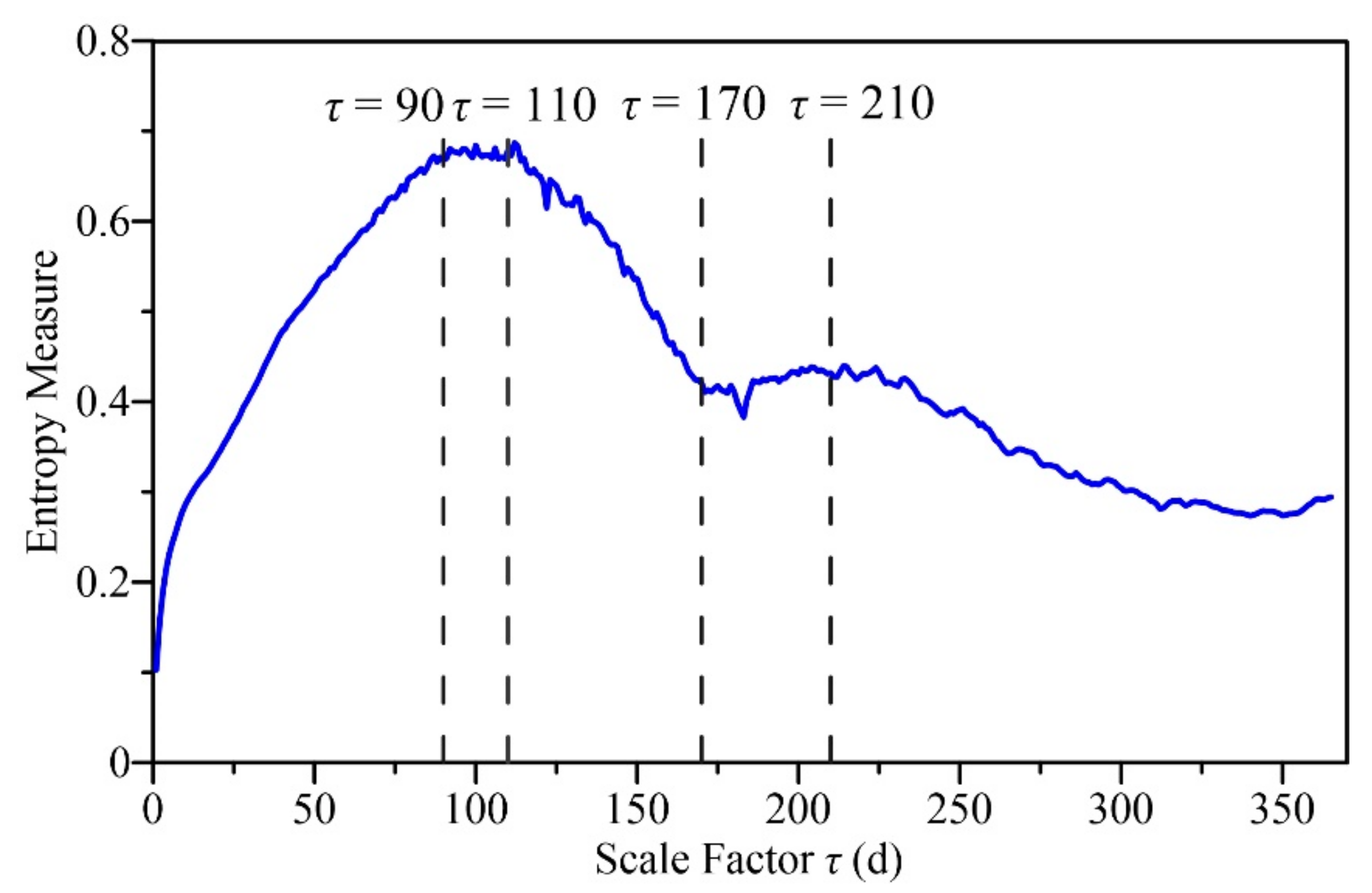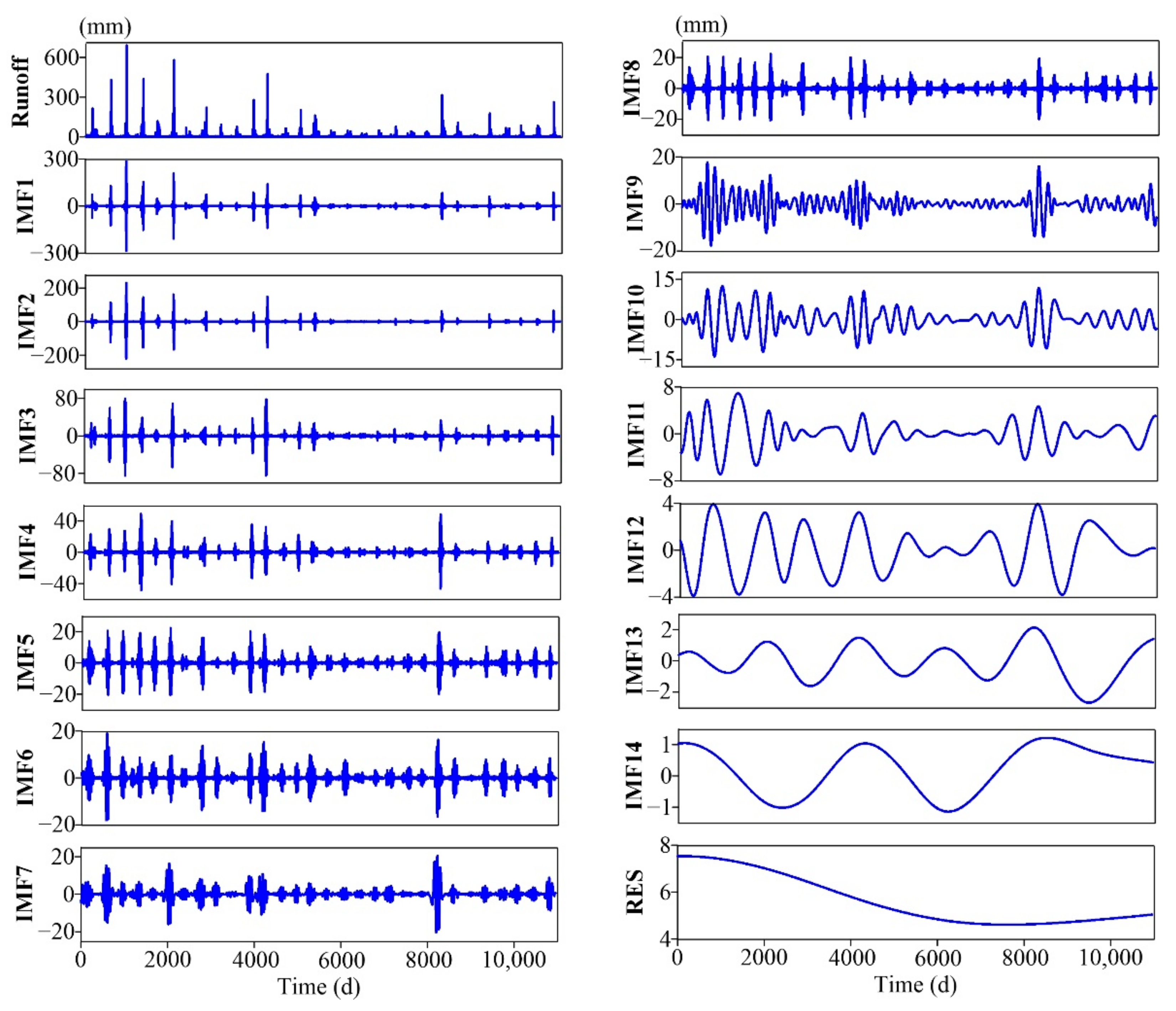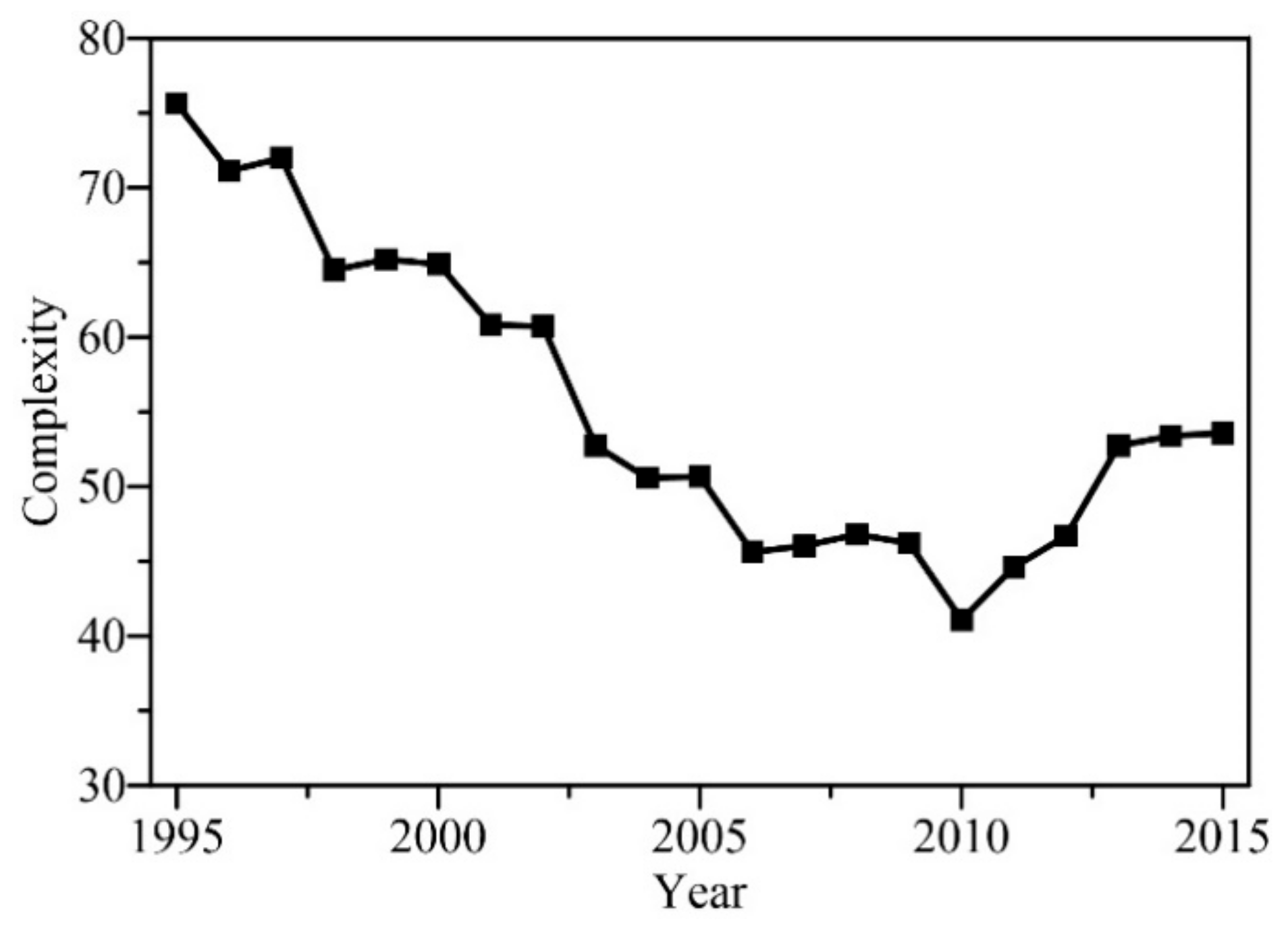Multiscale Analysis of Runoff Complexity in the Yanhe Watershed
Abstract
:1. Introduction
2. Materials and Methods
2.1. Study Area
2.2. Data Sources
2.3. Methods
2.3.1. Refined Composite Multiscale Entropy
2.3.2. Complete Ensemble Empirical Mode Decomposition with Adaptive Noise
3. Results
3.1. Multiscale Complexity Characteristics of Runoff
3.2. Trend Analysis of Runoff Complexity
4. Discussion
4.1. Characteristics of Runoff Complexity
4.2. Factors Impacting Runoff Complexity
5. Conclusions
Author Contributions
Funding
Institutional Review Board Statement
Informed Consent Statement
Data Availability Statement
Acknowledgments
Conflicts of Interest
References
- Lotspeich, F.B. Watersheds as the basic ecosystem: This conceptual framework provides a basis for a natural classification system. J. Am. Water Resour. Assoc. 1980, 16, 581–586. [Google Scholar] [CrossRef]
- Cheng, G.; Li, X. Integrated research methods in watershed science. Sci. China Earth Sci. 2015, 58, 1159–1168. [Google Scholar] [CrossRef]
- Wang, G.; Mang, S.; Cai, H.; Liu, S.; Zhang, Z.; Wang, L.; Innes, J.L. Integrated watershed management: Evolution, development and emerging trends. J. For. Res. 2016, 27, 967–994. [Google Scholar] [CrossRef]
- Pande, C.B. Watershed management and development. In Sustainable Watershed Development; Springer: Cham, Switzerland, 2020; pp. 13–26. [Google Scholar]
- Singh, R.K.; Jain, M.K. Complexity analyses of Godavari and Krishna river streamflow using the concept of entropy. Acta Geophys. 2021, 69, 2325–2338. [Google Scholar] [CrossRef]
- Wu, J.; Miao, C.; Zhang, X.; Yang, T.; Duan, Q. Detecting the quantitative hydrological response to changes in climate and human activities. Sci. Total Environ. 2017, 586, 328–337. [Google Scholar] [CrossRef]
- Kang, Y.; Gao, J.; Shao, H.; Zhang, Y. Quantitative analysis of hydrological responses to climate variability and land-use change in the hilly-gully region of the Loess Plateau, China. Water 2019, 12, 82. [Google Scholar] [CrossRef]
- Lian, L. Runoff forecasting model based on CEEMD and combination model: A case study in the Manasi River, China. Water Sci. Technol. Water Supply 2022, 22, 3921–3940. [Google Scholar] [CrossRef]
- Zheng, H.; Miao, C.; Zhang, G.; Li, X.; Wang, S.; Wu, J.; Gou, J. Is the runoff coefficient increasing or decreasing after ecological restoration on China’s Loess Plateau? Int. Soil Water Conserv. Res. 2021, 9, 333–343. [Google Scholar] [CrossRef]
- Chou, C.M. Complexity analysis of rainfall and runoff time series based on sample entropy in different temporal scales. Stoch. Environ. Res. Risk Assess. 2014, 28, 1401–1408. [Google Scholar] [CrossRef]
- Ma, W.; Yan, K.; Song, S. Analysis of streamflow complexity based on entropies in the Weihe River Basin, China. Entropy 2019, 22, 38. [Google Scholar] [CrossRef]
- Huang, F.; Ochoa, C.G.; Guo, L.; Wu, Y.; Qian, B. Investigating variation characteristics and driving forces of lake water level complexity in a complex river–lake system. Stoch. Environ. Res. Risk Assess. 2021, 35, 1003–1017. [Google Scholar] [CrossRef]
- Zhang, L.; Li, H.; Liu, D.; Fu, Q.; Li, M.; Faiz, M.A.; Khan, M.I.; Li, T. Identification and application of the most suitable entropy model for precipitation complexity measurement. Atmos. Res. 2019, 221, 88–97. [Google Scholar] [CrossRef]
- Pechlivanidis, I.G.; Jackson, B.; McMillan, H.; Gupta, H.V. Robust informational entropy-based descriptors of flow in catchment hydrology. Hydrol. Sci. J. 2016, 61, 1–18. [Google Scholar] [CrossRef]
- Rodríguez, R.A.; Rodrigo, R.; Juan, D.D. Ecology: Science or philately? An interdisciplinary analysis of sustainability by exploring if it is possible to get more and more information by reducing collateral environmental dam-ages. Sci. Total Environ. 2017, 596, 43–52. [Google Scholar] [CrossRef] [PubMed]
- Joo, H.; Jun, H.; Lee, J.; Kim, H.S. Assessment of a stream gauge network using upstream and downstream runoff characteristics and entropy. Entropy 2019, 21, 673. [Google Scholar] [CrossRef]
- Su, X.; Li, X.; Niu, Z.; Liang, X. A new complexity-based three-stage method to comprehensively quantify positive/negative contribution rates of climate change and human activities to changes in runoff in the upper Yellow River. J. Clean Prod. 2021, 287, 125017. [Google Scholar] [CrossRef]
- Richman, J.S.; Moorman, J.R. Physiological time-series analysis using approximate entropy and sample entropy. Am. J. Physiol.-Heart Circul. Physiol. 2000, 278, 2039–2049. [Google Scholar] [CrossRef]
- Sheikh, Z.; Alireza, M.N.; Dawei, H. Climate change impact assessment on low streamflows using cross-entropy methods. Clim. Res. 2021, 85, 159–176. [Google Scholar] [CrossRef]
- Huang, F.; Chunyu, X.; Wang, Y.; Wu, Y.; Qian, B.; Guo, L.; Zhao, D.; Xia, Z. Investigation into multi-temporal scale complexity of streamflows and water levels in the Poyang Lake basin, China. Entropy 2017, 19, 67. [Google Scholar] [CrossRef]
- Costa, M.; Goldberger, A.L.; Peng, C.K. Multiscale entropy analysis of biological signals. Phys. Rev. E 2005, 71, 021906. [Google Scholar] [CrossRef]
- Goldberger, A.L.; Peng, C.K.; Lipsitz, L.A. What is physiologic complexity and how does it change with aging and disease? Neurobiol. Aging 2002, 23, 23–26. [Google Scholar] [CrossRef]
- Costa, M.; Goldberger, A.L.; Peng, C.K. Multiscale entropy analysis of complex physiologic time series. Phys. Rev. Lett. 2002, 89, 068102. [Google Scholar] [CrossRef] [PubMed]
- Kang, H.G.; Costa, M.D.; Priplata, A.A.; Starobinets, O.V.; Goldberger, A.L.; Peng, C.K.; Kiely, D.K.; Cupples, L.A.; Lipsitz, L.A. Frailty and the degradation of complex balance dynamics during a dual-task protocol. J. Gerontol. Ser. A-Biol. Sci. Med. Sci. 2009, 64, 1304–1311. [Google Scholar] [CrossRef]
- Henriques, T.S.; Costa, M.D.; Mathur, P.; Mathur, P.; Davis, R.B.; Mittleman, M.A.; Khabbaz, K.R.; Goldberger, A.L.; Subramaniam, B. Complexity of preoperative blood pressure dynamics: Possible utility in cardiac surgical risk assessment. J. Clin. Monit. Comput. 2019, 33, 31–38. [Google Scholar] [CrossRef] [PubMed]
- Klinker, L.E.; Henriques, T.S.; Costa, M.D.; Davis, R.B.; Mittleman, M.A.; Mathur, P.; Subramaniam, B. Comparison of invasive and noninvasive blood pressure measurements for assessing signal complexity and surgical risk in cardiac surgical patients. Anesth. Analg. 2020, 130, 1653. [Google Scholar]
- Li, Z.; Zhang, Y.K. Multi-scale entropy analysis of Mississippi River flow. Stoch. Environ. Res. Risk Assess. 2008, 22, 507–512. [Google Scholar] [CrossRef]
- De Carvalho Barreto, I.D.; Stosic, T.; Filho, M.C.; Delrieux, C.; Singh, V.P.; Stosic, B. Complexity analyses of Sao Francisco river streamflow: Influence of dams and reservoirs. J. Hydrol. Eng. 2020, 25, 05020036. [Google Scholar] [CrossRef]
- Wu, S.D.; Wu, C.W.; Lin, S.G.; Lee, K.Y.; Peng, C.K. Analysis of complex time series using refined composite multiscale entropy. Phys. Lett. A 2014, 378, 1369–1374. [Google Scholar] [CrossRef]
- Wu, S.D.; Wu, C.W.; Lin, S.G.; Wang, C.C.; Lee, K.Y. Time series analysis using composite multiscale entropy. Entropy 2013, 15, 1069–1084. [Google Scholar] [CrossRef]
- Huang, N.E.; Shen, Z.; Long, S.R.; Wu, M.L.C.; Shih, H.H.; Zheng, Q.N.; Yen, N.C.; Tung, C.C.; Liu, H.H. The empirical mode decomposition and the Hilbert spectrum for nonlinear and non-stationary time series analysis. Proc. R. Soc. A-Math. Phys. Eng. Sci. 1998, 454, 903–995. [Google Scholar] [CrossRef]
- Torres, M.E.; Colominas, M.A.; Schlotthauer, G.; Flandrin, P. A complete ensemble empirical mode decomposition with adaptive noise. In Proceedings of the 2011 IEEE International Conference on Acoustics, Speech and Signal Processing (ICASSP), Prague, Czech Republic, 22–27 May 2011; pp. 4144–4147. [Google Scholar]
- Li, T.; Qian, Z.; He, T. Short-term load forecasting with improved CEEMDAN and GWO-based multiple kernel ELM. Complexity 2020, 2020, 1209547. [Google Scholar] [CrossRef]
- Liu, Y.; Wang, L.; Yang, L.; Liu, X.; Wang, L. Runoff prediction and analysis based on improved CEEMDAN-OS-QR-ELM. IEEE Access 2021, 9, 57311–57324. [Google Scholar] [CrossRef]
- Chen, W.; Li, J.; Wang, Q.; Han, K. Fault feature extraction and diagnosis of rolling bearings based on wavelet thresholding denoising with CEEMDAN energy entropy and PSO-LSSVM. Measurement 2021, 172, 108901. [Google Scholar] [CrossRef]
- Wang, C.; Zhao, H. Analysis of remote sensing time-series data to foster ecosystem sustainability: Use of temporal information entropy. Int. J. Remote Sens. 2019, 40, 2880–2894. [Google Scholar] [CrossRef]
- Bai, J.; Zhou, Z.; Zou, Y.; Pulatov, B.; Siddique, K.H. Watershed drought and ecosystem services: Spatiotemporal characteristics and gray relational analysis. ISPRS Int. J. Geo-Inf. 2021, 10, 43. [Google Scholar] [CrossRef]
- Li, E.H.; Mu, X.M.; Zhao, G.J.; Gao, P.; Shao, H.B. Variation of runoff and precipitation in the hekou-longmen region of the yellow river based on elasticity analysis. Sci. World J. 2014, 2014, 929858. [Google Scholar] [CrossRef]
- Lian, Y.; Sun, M.; Wang, J.; Luan, Q.; Jiao, M.; Zhao, X.; Gao, X. Quantitative impacts of climate change and human activities on the runoff evolution process in the Yanhe River Basin. Phys. Chem. Earth 2021, 122, 102998. [Google Scholar] [CrossRef]
- The hydrological yearbook of the Yellow River Basin. Available online: http://www.yrcc.gov.cn/ (accessed on 12 December 2021).
- Advanced Spaceborne Thermal Emission and Reflection Radiometer Global Digital Elevation Model. Available online: http://www.gscloud.cn/ (accessed on 6 December 2021).
- Yan’an Statistical Yearbook data for 2020. Available online: http://tjj.yanan.gov.cn/Item/5085.aspx/ (accessed on 6 December 2021).
- Cao, J.; Li, Z.; Li, J. Financial time series forecasting model based on CEEMDAN and LSTM. Phys. A 2019, 519, 127–139. [Google Scholar] [CrossRef]
- Wu, Z.; Huang, N.E. Ensemble empirical mode decomposition: A noise-assisted data analysis method. Adv. Adapt. Data Anal. 2009, 1, 1–41. [Google Scholar] [CrossRef]
- Meng, F.; Su, F.; Yang, D.; Tong, K.; Hao, Z. Impacts of recent climate change on the hydrology in the source region of the Yellow River basin. J. Hydrol.-Reg. Stud. 2016, 6, 66–81. [Google Scholar] [CrossRef]
- Cao, S.; Chen, L.; Yu, X. Impact of China’s Grain for Green Project on the landscape of vulnerable arid and semi-arid agricultural regions: A case study in northern Shaanxi Province. J. Appl. Ecol. 2009, 46, 536–543. [Google Scholar] [CrossRef]
- Xu, X.; Zhang, D.; Zhang, Y.; Yao, S.; Zhang, J. Evaluating the vegetation restoration potential achievement of ecological projects: A case study of Yan’an, China. Land Use Policy 2020, 90, 104293. [Google Scholar] [CrossRef]
- Notice on Improving the Policy of Grain for Green Project from the State Council. Available online: http://www.gov.cn/zwgk/2007-08/14/content_716617.htm (accessed on 14 August 2007).
- Feng, X.; Fu, B.; Piao, S.; Wang, S.; Ciais, P.; Zeng, Z.; Lü, Y.; Zeng, Y.; Li, Y.; Jiang, X.; et al. Revegetation in China’s Loess Plateau is approaching sustainable water resource limits. Nat. Clim. Chang. 2016, 6, 1019–1022. [Google Scholar] [CrossRef]








| IMF1 | IMF2 | IMF3 | IMF4 | IMF5 | IMF6 | IMF7 | IMF8 | IMF9 | IMF10 | IMF11 | IMF12 | IMF13 | IMF14 | |
|---|---|---|---|---|---|---|---|---|---|---|---|---|---|---|
| Mean Period/d | 2.91 | 3.62 | 3.59 | 6.45 | 12.2 | 22.69 | 41.67 | 89.09 | 171.22 | 342.44 | 576.74 | 1095.80 | 2191.60 | 3652.67 |
| IMF1 | IMF2 | IMF3 | IMF4 | IMF5 | IMF6 | IMF7 | IMF8 | IMF9 | IMF10 | IMF11 | IMF12 | IMF13 | IMF14 | |
|---|---|---|---|---|---|---|---|---|---|---|---|---|---|---|
| 6.09 | 4.23 | 6.96 | 8.76 | 15.18 | 25.61 | 38.82 | 55.38 | 73.10 | 72.91 | 40.67 | 35.66 | 40.96 | 18.40 |
Publisher’s Note: MDPI stays neutral with regard to jurisdictional claims in published maps and institutional affiliations. |
© 2022 by the authors. Licensee MDPI, Basel, Switzerland. This article is an open access article distributed under the terms and conditions of the Creative Commons Attribution (CC BY) license (https://creativecommons.org/licenses/by/4.0/).
Share and Cite
Liu, X.; Zhao, H. Multiscale Analysis of Runoff Complexity in the Yanhe Watershed. Entropy 2022, 24, 1088. https://doi.org/10.3390/e24081088
Liu X, Zhao H. Multiscale Analysis of Runoff Complexity in the Yanhe Watershed. Entropy. 2022; 24(8):1088. https://doi.org/10.3390/e24081088
Chicago/Turabian StyleLiu, Xintong, and Hongrui Zhao. 2022. "Multiscale Analysis of Runoff Complexity in the Yanhe Watershed" Entropy 24, no. 8: 1088. https://doi.org/10.3390/e24081088
APA StyleLiu, X., & Zhao, H. (2022). Multiscale Analysis of Runoff Complexity in the Yanhe Watershed. Entropy, 24(8), 1088. https://doi.org/10.3390/e24081088






